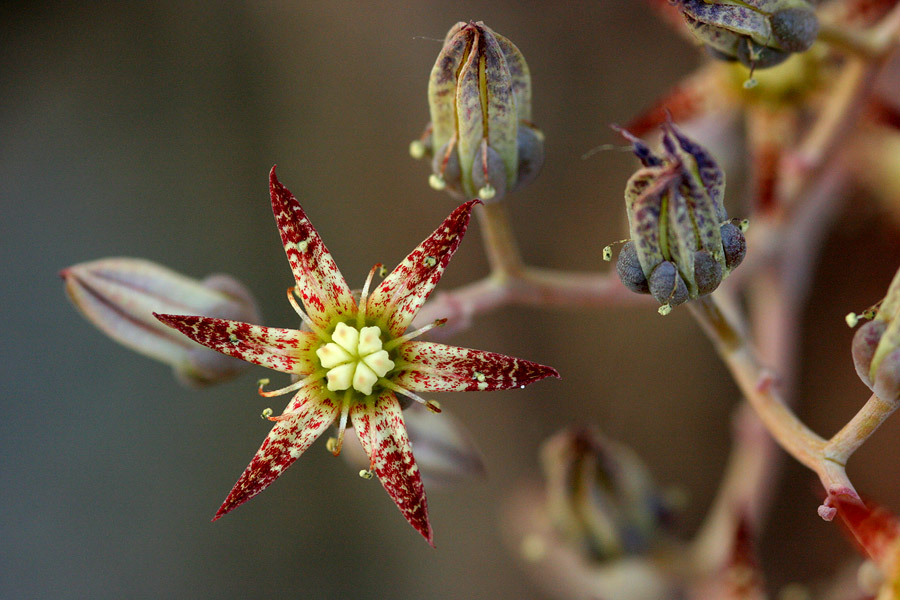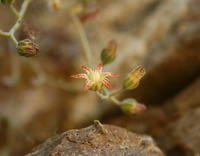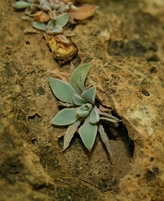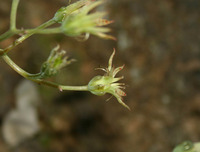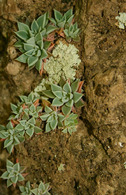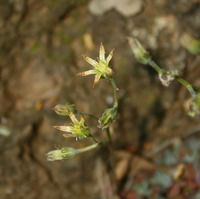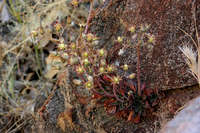Graptopetalum rusbyi
|
|
|
|
Family: Crassulaceae
San Francisco River Leather-Petal, more...San Francisco River leatherpetal, San Francisco leather petal, San Francisco River leatherpet
[Cotyledon rusbyi Greene, moreDudleya rusbyi (Greene) Britt. & Rose, Echeveria rusbyi (Greene) A. Nels. & J.F. Macbr., Graptopetalum orpetii E. Walther] |
Stems with ascending, slender branches, 3-10 mm thick. Leaves: rosettes densely ces-pitose, 10-50-leaved, 2-6(-10) cm diam.; blade green or reddish, rhombic-obovate to oblanceolate, 1.5-5 × 0.8-1.8 cm, rough (especially on margins and keel with peglike or subclavate papillae 0.05-0.1 mm and often narrower), apex with slender apiculum 1-3 mm, surfaces not glaucous. Inflorescences mostly flat cymes; floral stems 0.4-1.8 dm; proximal leaves 2-18 mm; branches mostly 2-5, circinate or not, 1-12-flowered. Pedicels mostly 3-8 mm. Flowers (5-)6-7(-8)-merous; corolla 14-21 mm diam., tube [0.7-]2-3.5 mm, lobes 7-10.5 × 1.2-2.5 mm; pistils not hollowed near base, gradually narrowed to styles 1-1.5 mm. 2n = 62, 63, 64, 66, ca. 93, 124. Flowering late spring. Rock crevices especially on north slopes and on shaded cliffs (at least at lower elevations); [0-]600-1700 m; Ariz.; Mexico (Chihuahua, Sinaloa, Sonora). Southward in Mexico, the corolla tube in Graptopetalum rusbyi tends to be shorter. The Mexican plants have been confused with G. occidentale Rose of Sinaloa (R. V. Moran 1984).
Plant: perennial herb; ROSETTES densely cespitose, 2-6(-10) cm wide, of 10-35(-50) leaves, on stems 3-10 mm thick Leaves: rhombic-obovate to oblanceolate, acute to acuminate, slender-apiculate, 1.5-5 cm long, 8-18 mm wide, 1-5 mm thick, not glaucous, with peg-like or subclavate papillae ca. as long as thick INFLORESCENCE: FLORAL STEMS 4-18 cm tall, with 5-22 leaves; branches mostly 2-5, spreading, 1-9 cm long, 1-12-flowered; pedicels mostly 3-8 mm long; cymes flat or paniculate, of 2-several one-sided branches Flowers: (5-)6-7(-8)-merous; sepals elliptic, 2.5-6 mm long, to 1.8 mm wide; corolla 14-21 mm wide, the tube in ours 2-3.5 mm long; pistils gradually narrowed to styles 1-1.5 mm long Fruit: FOLLICLES many seeded. SEEDS narrowly ovoid, reddish-brown, striate Misc: Locally common in scattered places, commonly in rock crevices especially on north slopes and on shaded cliffs (at least at lower elevations); 600-1650 m (2000-5400 ft); Apr-Jun REFERENCES: Moran, Reid. 1994. Bixaceae. J. Ariz. - Nev. Acad. Sci. Volume 27, 190-194. FNA 2009, Kearney and Peebles 1969 Duration: Perennial Nativity: Native Lifeform: Succulent General: Succulent perennials, to 35 cm tall, stems reddish with ascending, slender branches, floral stems annual, axillary, overtopping rosette, with scattered smaller leaves, herbage glabrous or papillose. Leaves: Alternate, persistent, in densely tufted, basal rosettes, rosettes 10-50-leaved, 2-10 cm in diameter, blades green or reddish, rhombic-obovate to oblanceolate, 1.5-5 cm long and to 2 cm wide, apices with slender apiculum 1-3 mm, cauline or infloresence leaves (proximal) leaves 2-18 mm long, surfaces rough, especially on the margins and keel with peglike or subclavate nodules (papillae), not glaucous, blades sessile or subclasping and narrowing basally. Flowers: Deep maroon with white or cream-colored spots and stripes and yellow centers, appearing to have spreading, lanceolate petals, 5-8-merous, corollas 14-21 mm in diameter, tubes 2-3.5 mm long, lobes 7-10.5 mm long and 1.2-2.5 mm wide, pistils not hollowed near base, gradually narrowed to styles 1-1.5 mm long, inflorescences mostly flat cymes, floral stems 4-18 cm long, branches mostly 2-5, circinate or not, 1-12-flowered, pedicels mostly 3-8 mm long. Fruits: Whorls of follicles, each follicle dehiscent along an adaxial suture, unripe follicles erect. Seeds 1-20 or more, brown, narrowly ovoid, surfaces finely grooved with small nodules (papillose). Ecology: Found in open places among rocks, in rock crevices, especially on north slopes and on shaded cliffs, from 0-5,500 ft (0-1676 m); flowering late spring. Distribution: Arizona; Mexico. Notes: This interesting plant has fleshy and succulent leaves and stems, the individuals often growing in small mats. The deep green leaves in dense, wrinkly rosettes sprout brownish-red stems of striking flowers subtended by smaller proximal leaves. The flowers appear to have 5-8 thin and lanceolate petals (actually sepals) of deep maroon with cream-colored white spots and stripes and yellow centers. When not in bloom, the buds are thick and reddish-green or yellowish. Look for this species in Arizona in Greenlee, Graham, Gila, Maricopa, Pinal, and Pima counties. Ethnobotany: Unknown. Etymology: The meaning of echeveria is unknown, and rusbyi is named after Henry Hurd Rusby (1855-1940). Synonyms: Echevaria rusbyi, Graptopetalum orpetii Editor: LCrumbacher2012 |

